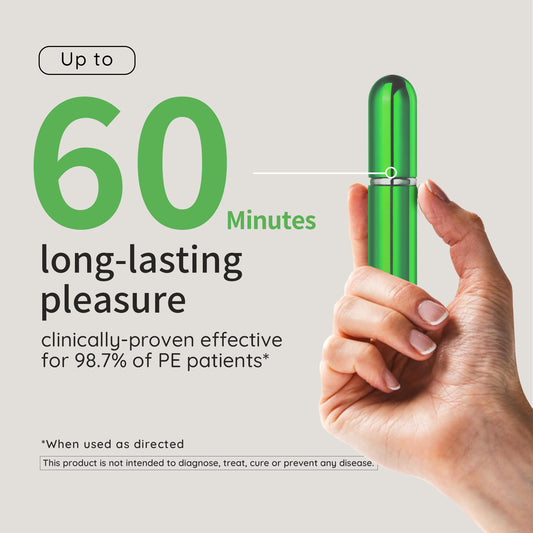Introduction
Edging is a sexual practice where orgasm is deliberately delayed. It has gained popularity among men who want to improve their sexual and hormonal health. But is edging good for testosterone, or does it negatively affect hormone levels?
Understanding the connection between edging and testosterone can help clarify whether this practice is beneficial or harmful. This article explores how edging affects testosterone and other aspects of sexual and overall health.

If you're looking to prolong your sexual experience, explore the benefits of the EjaGuard Delay Spray, which may support extended pleasure during edging.
What Is Edging?
Edging involves sexual stimulation up to the brink of orgasm, then intentionally stopping before climax. This technique is often used to prolong sexual pleasure, improve orgasm control, or even enhance intimacy during sexual intercourse. For some, it’s a form of training to delay ejaculation and increase sexual stamina.
The practice of edging can be done alone or with a partner, and it’s closely related to methods like the start-stop technique. Delaying orgasm can help individuals gain more control over their climax.
The American Urological Association offers expert insights into techniques that improve sexual stamina, including those that align with edging practices.
Testosterone and Sexual Activity
Testosterone, the primary male sex hormone, plays a crucial role in libido, energy levels, muscle growth, and overall well-being. Sexual activity has long been linked to fluctuations in testosterone levels. For instance, engaging in sexual intercourse or experiencing sexual stimulation can cause temporary spikes in testosterone levels.
Hormone levels tend to increase during arousal due to heightened physical and emotional stimulation. However, studies suggest that reaching orgasm often triggers a return to baseline or slightly decreased testosterone levels. This interplay raises questions about how delaying orgasm through practices like edging might influence the body’s hormonal balance.
Our Penis Enlargement Cream may complement your efforts in improving sexual performance and hormone balance.

Does Edging Boost Testosterone?
One of the most frequently asked questions is, 'Does edging increase testosterone?' While research on this specific topic is limited, some insights suggest that edging may temporarily sustain heightened testosterone levels due to prolonged arousal. The theory is that keeping the body in a state of arousal without reaching orgasm could maintain the hormonal surge associated with sexual stimulation.
However, there is no definitive evidence that edging significantly boosts testosterone levels long-term. Hormonal responses can vary widely among individuals, influenced by factors such as age, stress levels, and overall health. It’s crucial to approach this topic with realistic expectations and consult a healthcare professional if considering edging for hormonal benefits.
To dive deeper into the biological aspects of testosterone levels and sexual health, read this study from Harvard Health.
Other Potential Benefits of Edging
Beyond its potential effects on testosterone, edging offers several other benefits for sexual and reproductive health:
- Improved Sexual Stamina: Delaying orgasm can help individuals increase their sexual endurance over time.
- Increased Sperm Count: Some believe that prolonged arousal before ejaculation could improve sperm quality and count, although more research is needed.
- Enhanced Orgasm Control: Regular practice of edging allows individuals to develop better control over their climax, reducing the likelihood of premature ejaculation.
Edging may also serve as a psychological training tool, helping individuals feel more confident and in control during sexual activity. However, these benefits should be balanced against potential risks.

Risks and Drawbacks of Edging
While edging can be beneficial, it’s not without its potential risks. Prolonged or repeated edging sessions could lead to:
- Erectile Dysfunction: Constantly stopping before orgasm may condition the body to struggle with maintaining an erection.
- Delayed Ejaculation: Over-reliance on edging might result in difficulty achieving orgasm in regular sexual situations.
- Psychological Stress: For some, the pressure to 'perform' during edging sessions can lead to anxiety or reduced enjoyment of sex.
Maintaining a balanced approach to edging and other sexual practices is essential to avoid these potential issues.
Edging Techniques and Methods
If you’re interested in practicing edging, there are a few common techniques to consider:
- Start-Stop Method: Pause stimulation as you approach the point of orgasm, then resume once the sensation subsides.
- Squeeze Method: Apply gentle pressure to the base or tip of the penis to delay ejaculation.
- Controlled Breathing: Focus on deep, steady breaths to manage arousal and maintain control.
Incorporating these methods into your routine can enhance your ability to delay orgasm while still enjoying the experience.To enhance your edging experience, try using our Dildos for added sensation and control.

Edging vs. Testosterone Replacement Therapy (TRT)
For those considering edging as a natural alternative to testosterone replacement therapy (TRT), it’s important to understand the differences. While edging may provide temporary hormonal benefits, TRT is a medical treatment designed to address clinically low testosterone levels.
TRT involves prescribed hormones and regular monitoring by a healthcare provider, making it a more reliable solution for significant testosterone deficiencies. Edging, on the other hand, is a complementary practice that may support overall sexual health but should not replace medical interventions when needed.
If you're considering TRT as a long-term treatment, the National Institute on Aging offers information on testosterone therapy and its effects on health.
FAQs on Edging and Testosterone
1. Does edging increase testosterone levels? Edging may sustain elevated testosterone levels temporarily during arousal, but its long-term effects on hormone levels are unclear.
2. Is edging bad for testosterone? There’s no evidence suggesting that edging harms testosterone levels, but overuse could lead to other sexual health issues.
3. Can edging increase sperm count? Some believe edging might improve sperm quality by delaying ejaculation, though more research is needed to confirm this.
4. How does edging affect sexual stamina? Edging can help improve sexual stamina by training individuals to control their climax more effectively.
Conclusion
Edging involves delaying orgasm to enhance sexual experience and potentially influence hormone levels. While there are anecdotal reports suggesting it may temporarily boost testosterone, scientific evidence remains limited. This practice offers benefits like improved sexual stamina and orgasm control but should be approached with caution to avoid risks such as erectile dysfunction or delayed ejaculation.

Whether you are practicing edging or exploring other methods of sexual enhancement, EjaGuard’s Sex Toys can offer additional support in extending pleasure and control.
 Buy Now
Buy Now



